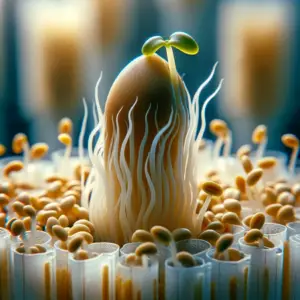Aeroponics is a modern method of growing plants where roots are suspended in the air and misted with a nutrient-rich solution. This technique offers several advantages, including faster growth rates and efficient use of resources. However, a common question among new aeroponic gardeners is whether normal seeds can be used in an aeroponic system. In this article, we will explore the viability of using regular seeds in aeroponics, the best practices for germination, and tips for successful aeroponic gardening.

Understanding Aeroponics
Aeroponics is a soil-less growing method where plants’ roots are continuously or intermittently misted with a nutrient solution. This system allows for better oxygenation of the roots, leading to more efficient nutrient absorption and faster growth. Aeroponics is particularly suitable for growing leafy greens, herbs, and certain vegetables.
Can You Use Normal Seeds in Aeroponics?
Yes, you can use normal seeds in an aeroponic system. Regular seeds, whether purchased from a garden center or harvested from previous crops, can be germinated and grown in an aeroponic setup. However, there are certain steps and considerations to ensure successful germination and growth.
Germinating Seeds for Aeroponics
The first step in using normal seeds for aeroponics is germination. Seeds need a moist environment to sprout, and while aeroponics systems are excellent for growing plants, they are not typically designed for germinating seeds directly. Here’s how to successfully germinate seeds for aeroponics:
Step 1: Pre-soaking Seeds
Before placing seeds in an aeroponic system, it is beneficial to pre-soak them in water for 12-24 hours. This softens the seed coat and promotes faster germination.
Step 2: Using Seed Starters
Use seed starter plugs, rockwool cubes, or peat pellets to germinate the seeds. These mediums retain moisture and provide a stable environment for seeds to sprout. Place the seeds into the chosen medium and keep it moist.
Step 3: Providing the Right Conditions
Keep the seed starters in a warm, humid environment. A seedling heat mat and a humidity dome can help maintain the ideal conditions for germination. Ensure they receive indirect light or use a low-intensity grow light to encourage sprouting.
Step 4: Transferring to Aeroponic System
Once the seeds have germinated and the seedlings have developed their first true leaves, they can be transferred to the aeroponic system. Gently place the seedlings with their growing medium into the aeroponic net pots, ensuring the roots have access to the nutrient mist.
Best Practices for Growing Aeroponic Plants
To maximize the success of your aeroponic garden, follow these best practices:
Choose the Right Nutrient Solution
Using a balanced nutrient solution specifically formulated for aeroponics is crucial. Ensure it contains all the necessary macro and micronutrients for healthy plant growth. Regularly check and adjust the pH of the nutrient solution to maintain it between 5.5 and 6.5.
Maintain Proper Lighting
Adequate lighting is essential for the growth of aeroponic plants. Use full-spectrum LED grow lights to provide the necessary light spectrum for all growth stages. Ensure the plants receive 14-16 hours of light per day during the vegetative stage and 12 hours during the flowering stage.
Recommended Product: Growace Full-Spectrum LED Grow Lights
Monitor Environmental Conditions
Maintain optimal temperature and humidity levels for your plants. Most aeroponic plants thrive in temperatures between 65°F and 75°F (18°C to 24°C) and humidity levels around 50-70%. Use fans to ensure good air circulation and prevent mold and mildew.
Regular Maintenance
Regularly inspect your aeroponic system for any clogs, leaks, or malfunctions. Clean the misting nozzles and nutrient reservoir to prevent the buildup of algae and other contaminants. Regular maintenance ensures the efficient functioning of your system and the healthy growth of your plants.
Final Thoughts
Using normal seeds in an aeroponic system is not only possible but can be highly successful with the right approach. By properly germinating the seeds and following best practices for aeroponic gardening, you can enjoy the benefits of this innovative growing method. With careful attention to nutrient solutions, lighting, and environmental conditions, your aeroponic garden can thrive, providing you with fresh, healthy produce.
